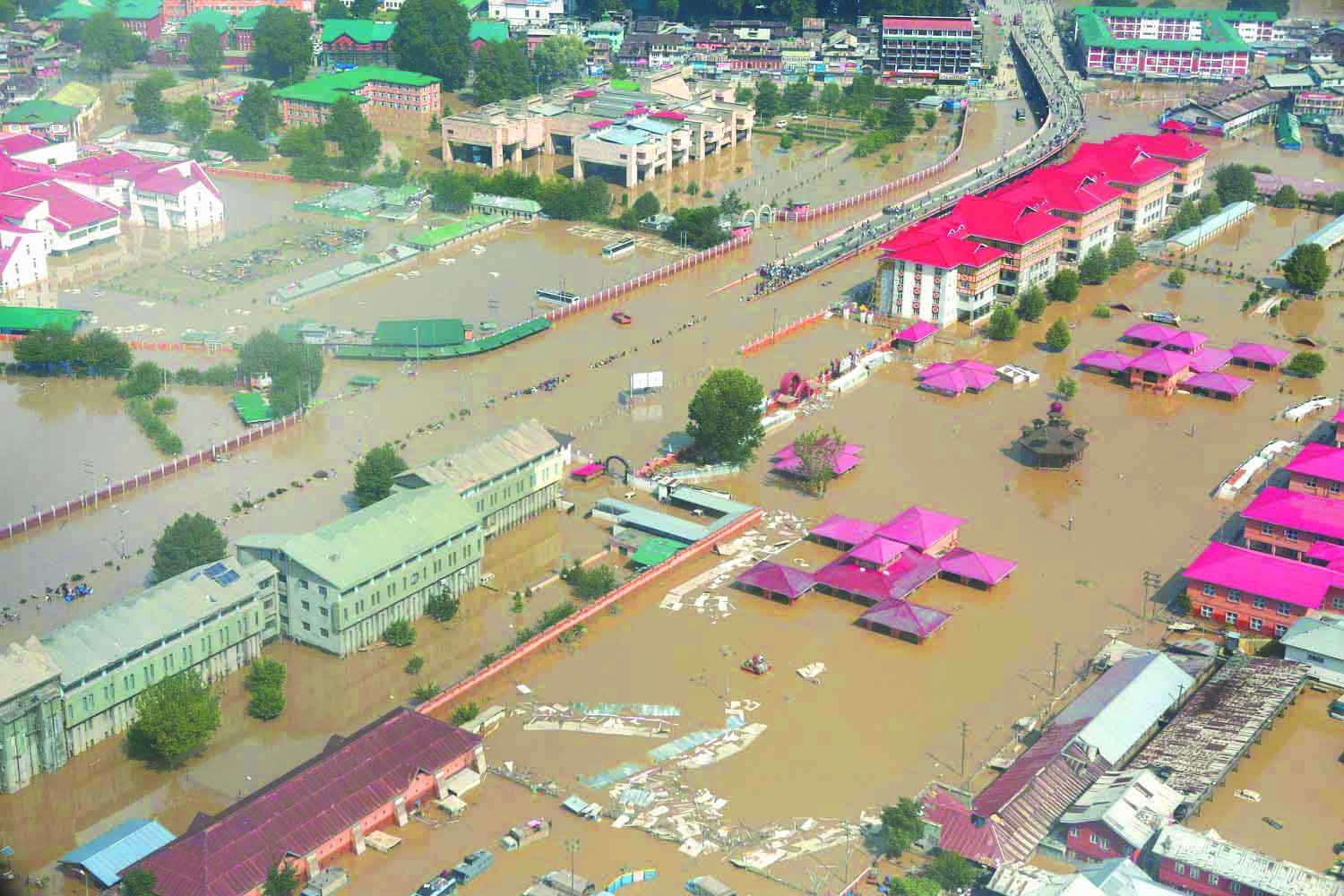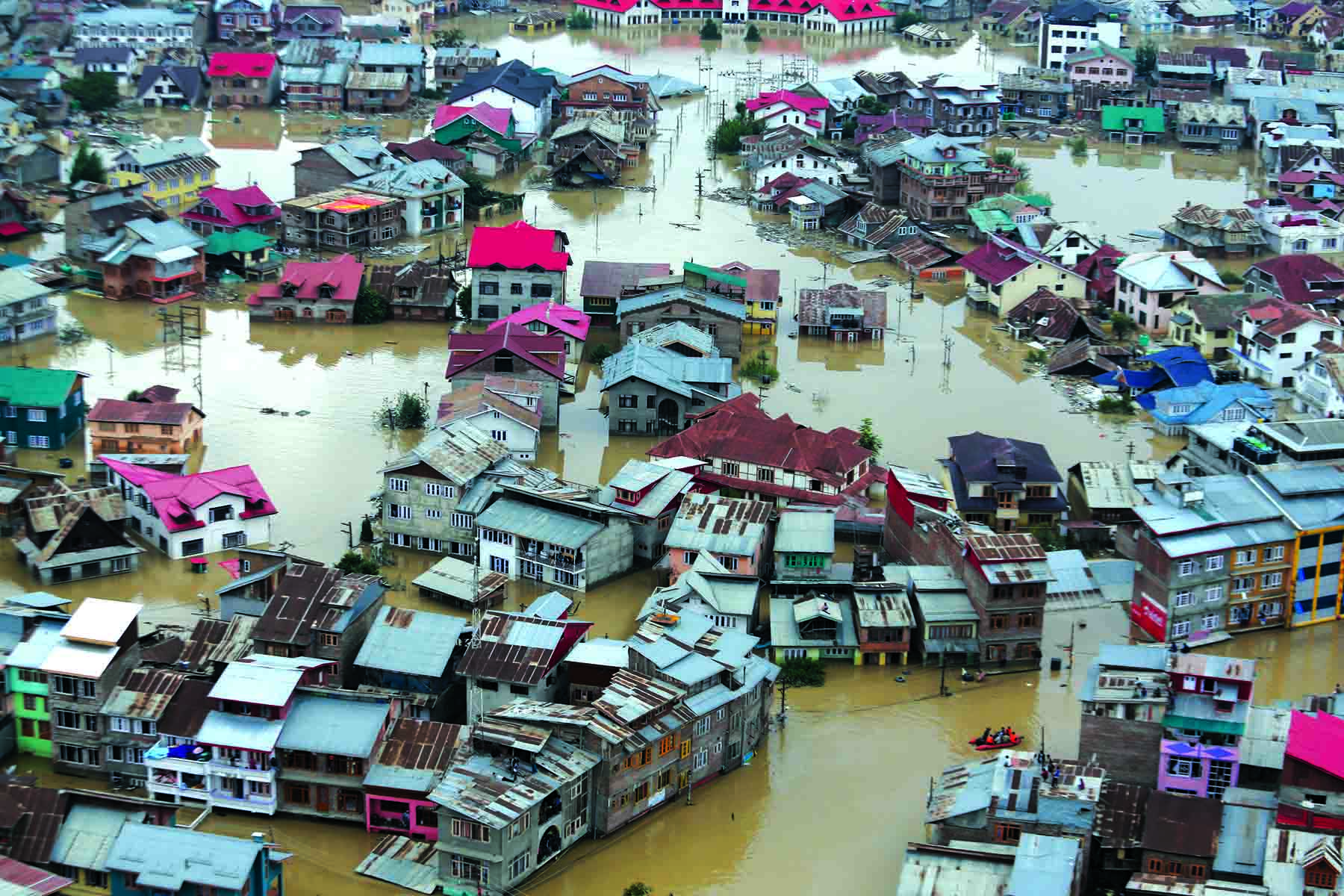While not every coin allocated for post-flood revival reached Srinagar, Comptroller and Auditor General has revealed that money spent has not followed the schemes and the script, Tahir Bhat reports

Notwithstanding the claims that adequate protections were created against floods in wake of the devastation wreaked by the September 2014 floods, the Comptroller and Auditor General (CAG) has identified a basket of issues in the implementation of a number of grants. The floods had impacted seriously around 850 square km with Srinagar as epicentre where inundation was between 1.5 to six meters.
In its recent report, the CAG has audited the expenditures under four different heads – Rs 2000 crore for restoration of the damaged public infrastructure; Rs 399.29 crore for (Phase-I) of strengthening of Jhelum banks and Flood Spill Channel (FSCL); Rs 1194 crore relief to families devastated in the floods and another Rs 800 crore for the revival of business.
Though not every coin allocated for the four projects did reach Jammu and Kashmir, the CAG audited the funds released till fiscal 2019 and found various things unaddressed, even after the money was spent.
Managing Jhelum
On the flood management side, the focus was on increasing the carrying capacity of the FSC while improving the banks of the river so that no breaches occur. FSC, CAG said was a critical part of the project. The 49 km channel connecting Padshahi Bagh with Wullar lake was dug in 1904 and has only the capacity of only 8000 cusecs, according to CAG auditors. In order to enhance its capacity, the scheme envisaged acquiring 1,761 and 13 marlas of land in Sharefabad and Naidkhai for widening FSL; earth-cutting at both these places and having two bridges. Besides, the government also had to dredge out silt in Srinagar and Baramulla. In four years ending March 2019, the net availability of funds was Rs 287.43 crore, which was almost spent. Though the project was supposed to conclude by 2017, it could not complete even after the extension till March 2019.
CAG found out that by the end of March 2019, only 1,683 kanals and 10 marlas land (worth Rs 43.60 crore) has been acquired. As many as 24 structures coming within the ambit of FSC’s widening portion were neither dismantled nor taken over.
The Flood Spill Channel
Sedimentation and encroachments over the years, CAG said had reduced the FSC’s carrying capacity to 6000 cusecs and to increase it to 8700 cusecs, 18.11 lakh cubic meters of earth was to be excavated. By March 2019, 13.13 lakh cum were excavated. Bridges also remained incomplete.
For the better flow of water, dredging of Jhelum was a priority. Engineers had identified various spots where there was no option but to dredge out the deposits. Almost seven lakh cum of bed material was to be dredged at six places between Bell mouth (off-take point of FSC at Padhshahi Bagh Srinagar) to Panzinara (6.07 Km). Kolkotta based Reach Dredging Ltd bagged the Rs 20.23 crore contract. The contractor dredged out only 0.84 lakh cum bed material (12 per cent) up to January 2017 and attracted the forfeiture of the performance guarantee as per the terms of the contract. Later, the department shifted the dredging sites to other spots outside the scope of DPR. After two extensions, the contractor dredged out 6.86 lakh cum only. Of the six places, one spot was never touched and at three spots excessive dredging took place.
In order to improve the downstream flow, 9.15 lakh cum was to be dredged out between Sopore and Sheeri at a cost of Rs 26.77 crore in 20 months. The contractor dredged out only 7.41 lakh cum material (81 per cent) and took Rs 21.66 crore leaving 1.74 lakh cum sedimentations in the river.
Bottlenecks
Experts had identified two spots upstream between Khandal and Pampore to remove shoal and clear bottlenecks. Around 60,000 cum was to be dredged out between Sether and Sempore (Pampore). It was left untouched. Between Khanabal and Kadlabal, 142000 cum was to be removed and only 11698 cum was dredged out. Officials told CAG that it was done on the recommendations of the Central Water and Power Research Station (CWPRS) which advised against dredging in head reaches as it would be counterproductive.
Against the allocation of Rs 2000 crore for the restoration of damaged public infrastructure, a sum of Rs 875.98 crore was spent by seven departments by the end of March 2019. Though they completed 6397 works, more than one-third of the identified works remain unfinished. CAG has found an interesting style in expenditure on this account as countless works have been executed in places where there was no flood.
Devastated Homes
The CAG revealed that the overall relief extended to Jammu and Kashmir society after the September 2014 devastating floods was less than Rs 2000 crore. The relief was part of the Prime Minister’s Developmental Plan (PMDP). While around Rs 1194 crore was meant for the devastated homes, Rs 800 crore was the relief extended to businesses by way of interest subvention.
While the destructed was wrecked in low lying areas living on the banks of Jhelum with Srinagar city taking most of the hit, Kashmir actually got only Rs 868 crore for rebuilding the devastated homes and the rest of Rs 217.48 crore were spent in the Jammu division. Srinagar, however, got the lion’s share of Rs 500 crore for rebuilding homes.
A general estimation suggests that the overall losses in Kashmir alone were to the tune of Rs 100 thousand crore. Damages were huge because most of the business hub in Srinagar was underwater.
Now the CAG has offered details of the devastation and also pinpointed the problems in the distribution of the relief. The assessment was bifurcated into pacca and kaccha houses and the extent of damage was taken into account under three categories – fully damaged, severely and partially. The floods have touched 890 thousand houses of which more than 592 thousand were fully destroyed.
Apart from pinpointing the delay in the distribution of the relief to the affected, the CAG report has highlighted the crisis in the gathering of numbers of affected households. The inability of the governance system in creating centralised data of the damaged civil infrastructure, CAG pointed out has made it impossible to locate the number of families who were not supported by the government. In Srinagar, for instance, the government said the total number of houses that were damaged by the floods was 92120. But CAG has mentioned that only 86973 households were helped under SDRF, 78633 families got PMNRF support and only 77569 were helped under PMDP. Ideally, all the affected households should have got support from the three major heads.
“In Srinagar district, the category of 405 damaged households were revised (May 2016) by the Deputy Commissioner (DC), Srinagar based on representations by the affected owners of houses. This was done after the cut-off date of 31 March 2016 and therefore, could not be uploaded on PFMS. Therefore, the owners of these houses were deprived of the additional amount in the second tranche and financial assistance of Rs 4.52 crore under the PMDP as per their entitlement in the revised category. No mechanism for relaxation of condition for payment under the PMDP or to get beneficiaries uploaded after 31 March 2016 was evolved by the department,” the CAG pointed out. “In five Tehsils of Jammu district, 425 damaged households identified by the Survey Committee after the floods of September 2014, were not paid assistance of Rs 1.48 crore under the PMDP as of August 2020. No reasons were furnished by the DC, Jammu despite specifically being asked in Audit.”

Not Touched By Flood
CAG has also pointed out that a number of families were given relief despite never being touched by the floods. From seven tehsils of Jammu, it has identified 184 families getting Rs 63.45 lakh without any damage to their properties.
“In two Tehsils (out of 6 Tehsils) selected for test check, in Poonch district, the names of 60 beneficiaries to whom assistance was paid (September 2019) did not exist in the SDRF beneficiary list, thereby resulting in inadmissible payment of assistance of Rs 14.50 lakh under the PMDP,” the CAG pointed out. “In two tehsils of Poonch district, 147 households7 under three categories (Kacha fully, Kacha partially and Pucca severely) were subsequently added to the list of damaged houses finalised under SDRF and paid assistance under the PMDP. This resulted in an inadmissible payment of assistance of Rs 37.45 lakh to these 147 ineligible beneficiaries.”
The report has also pointed out in certain cases a small section of families got more than what they deserve. In test checks, it has identified 85 families getting an excess of Rs 73.85 lakh. After the issue was pinpointed by the CAG, the respective Deputy Commissioner’s have asked the subordinate officers to start the recovery process in all these cases. Some districts like Rajouri have still funds in their coffers
Support to Business
What was devastating in these floods was that they hit businesses by destroying the infrastructure and playing with the purchasing capacity of the people. For almost three months, nothing much was happening in Srinagar, the main trading hub in Kashmir. The only major relief that the trade got was insurance.
In 2018, Jammu and Kashmir launched the Chief Minister’s Business Interest Relief Scheme (CMBIRS) announcing that the government will contribute one-third of the monthly instalment or interest payment of the borrower if he had actually paid two-thirds of it earlier. The scheme was applicable to the restructured accounts affected by the floods of September 2014 as also the accounts restructured after the unrest of 2016.
Under the CMBIRS, the government released Rs 200 crore in favour of the JKSLBC between March 2018 and March 2019. Out of this, an amount of Rs 199.96 crore was remitted up to March 2019 to 1556 banks operating in Jammu and Kashmir.
The CAG report has pointed out that out of the release of Rs 190.20 crore to JKBL Rs 41.32 crore was provided to only 19 borrowers including 10 who were not affected by the floods but still got Rs 21.02 crore. It has said these accounts had been restructured after the 2016 unrest as well.
Besides, the CM secretariat released Rs 101.89 crore to various districts for payment to small traders and business units with turnover up to Rs 10 lakh and not linked to the formal credit system. The two interventions have covered a total of 50081 businesses across Jammu and Kashmir.
These observations are being talked about by certain sections suggesting as if it was largesse. In floods, like in unrest, all businesses suffer. The companies that were helped by way of interest subvention are the major employers in Kashmir’s private sector.















